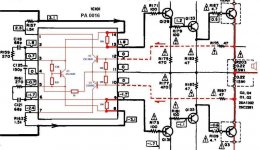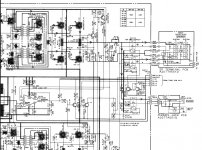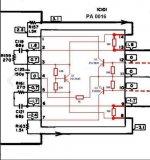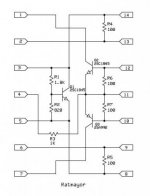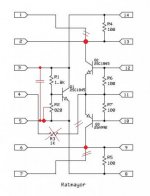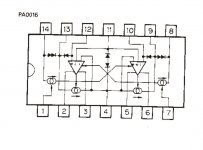Who can upload this AES paper:
AES E-Library >> THE AUTOBIAS AMPLIFIER: A New Topology for Automatically Biased Audio Amplifiers Using Power MOSFETs....
AES papers are copyright. They probably should not be posted.
What seems to be the same article was published in a book:
MOSPOWER applications – 1984 - Rudy SEVERNS
Publisher: Siliconix, 1985
ISBN 10: 0930519000 ISBN 13: 9780930519001
This is the most MOSPOWER info ever put between two covers.
You can buy your own for not a lot of money.
MOSPOWER applications handbook: Rudy (ed) SEVERNS: Amazon.com: Books
Mospower Applications Handbook by Rudy Severns - AbeBooks
Thank you for this posting.
By chance I have discover various BIAS servo IC's like Pioneer's PA0016 - go to
Предложено На Форуме - Страница 2 - Усилитель мощности А. Лайкова - Форум по радиоэлектронике
Are the internal circuit from the attachment well suited as a replacement for common vbe multiplier? Or should I prefer one of the other showed designs (JVC's VC5022, ROHM's BA3122N or one of the discrete design's) ?
What are the pros and cons of each ?
Check out also post #15 under
Help with schematic
Thank you very much for advices.
By chance I have discover various BIAS servo IC's like Pioneer's PA0016 - go to
Предложено На Форуме - Страница 2 - Усилитель мощности А. Лайкова - Форум по радиоэлектронике
Are the internal circuit from the attachment well suited as a replacement for common vbe multiplier? Or should I prefer one of the other showed designs (JVC's VC5022, ROHM's BA3122N or one of the discrete design's) ?
What are the pros and cons of each ?
Check out also post #15 under
Help with schematic
Thank you very much for advices.
Attachments
Last edited:
URL is death. But this URL goes open:have anybody tested this topology?
http://home.tiscali.nl/data.odyssey/AutoBias.html
Auto Bias
Thank you for this posting.
By chance I have discover various BIAS servo IC's like Pioneer's PA0016 - go to
Предложено На Форуме - Страница 2 - Усилитель мощности А. Лайкова - Форум по радиоэлектронике
Are the internal circuit from the attachment well suited as a replacement for common vbe multiplier? Or should I prefer one of the other showed designs (JVC's VC5022, ROHM's BA3122N or one of the discrete design's) ?
What are the pros and cons of each ?
Check out also post #15 under
Help with schematic
Thank you very much for advices.
PA0016 clone:
RT22.RU Радиотехника 20 века, форумы • Просмотр темы - Микросхемы Pioneer PA0016
Attachments
Last edited:
another approaches.
Pioneer a obvod PA0016 (Stranka 1) - Zesilovače, receivery - Audioweb.cz
Amplificator Pioneer defect - Page 2 - Radio-TV, Audio-video Repair - ELFORUM - Forumul electronistilor
Ampli Pioneer modello A-X430 finali bruciati - Radio - Stereo - Autoradio - HiFi - CD - DVD - PLC Forum
Pioneer a obvod PA0016 (Stranka 1) - Zesilovače, receivery - Audioweb.cz
Amplificator Pioneer defect - Page 2 - Radio-TV, Audio-video Repair - ELFORUM - Forumul electronistilor
Ampli Pioneer modello A-X430 finali bruciati - Radio - Stereo - Autoradio - HiFi - CD - DVD - PLC Forum
Attachments
Last edited:
A colleague, who was no slouch, failed to get the LT1166 from oscillating into some loads. A lovely idea, but it had issues.
I successfully adapted Mr Gevel's approach from N FETs to complimentary triple emitter followers. It instantaneously set up bias, was non switching and halved THD at HF (the crossover residual) on and already clean amp. 8 biploars and some passives.
I successfully adapted Mr Gevel's approach from N FETs to complimentary triple emitter followers. It instantaneously set up bias, was non switching and halved THD at HF (the crossover residual) on and already clean amp. 8 biploars and some passives.
A colleague, who was no slouch, failed to get the LT1166 from oscillating into some loads. A lovely idea, but it had issues.
I worked with them for a while, and finally gave up. Smarter than me,
Bob Cordell doesn't seem to have been happy with them either.

Hello,
Any link to the Mr Gevel approach ??
It was in EE&WW:
Gevel, van de, Marcel, Audio power with a new loop, EW+WW, Feb 1996
He is on this forum. You can ask him. A very well informed engineer.
I worked with them for a while, and finally gave up. Smarter than me,
Bob Cordell doesn't seem to have been happy with them either.

It is quite easy to do with discrete matched pairs of transistors. The 10:1 ratio LT1166 has takes more parts, so I changed it to the constant sum of 2 exponents. The quiescent ends up a little higher than optimally biased class B, but the zero switching and smooth transition seems worthwhile, along with the zero settling time in production. Also you can remove the emitter resistors and use collector resistors to sense the current if that takes your fancy.
Hi tiefbassuebertr,
I hope that you [and all] are well and safe. The thread Class aP amplification in the Pass Labs Forum is a candidate to consider in your quest.
Best
Anton
I hope that you [and all] are well and safe. The thread Class aP amplification in the Pass Labs Forum is a candidate to consider in your quest.
Best
Anton
It is quite easy to do with discrete matched pairs of transistors. The 10:1 ratio LT1166 has takes more parts, so I changed it to the constant sum of 2 exponents. The quiescent ends up a little higher than optimally biased class B, but the zero switching and smooth transition seems worthwhile, along with the zero settling time in production. Also you can remove the emitter resistors and use collector resistors to sense the current if that takes your fancy.
So now it's Wayne, ZM, Rothacher, Cordell and you that's smarter than me.

ZM versteht nur Bahnhof ...... 
I mean generally ....... and in this particular case - never had LT1166 in hands
so, just ignore Mighty Moi being on above list ........

I mean generally ....... and in this particular case - never had LT1166 in hands
so, just ignore Mighty Moi being on above list ........
So now it's Wayne, ZM, Rothacher, Cordell and you that's smarter than me.

No no sir. Mr Gevel maybe on your level, but I merely get inspired from those who are around me, and re-arrange things until they work and sound better...
I have a couple of other versions, including a rail to rail one using p-channels on the positive rail and n-ch on the negative. I haven't built that one yet. Young engineers appear to be scared of the 3 legged devices, and it was vetoed on their protestations.
1. Diode clamped bias servos
2. (possibly diode clamped) minimum current regulation on one side bias follower.
3. base current sensor bias (~backwards) transistor (as per LV)
4. switching fast drivers, not slower OPs.
2. (possibly diode clamped) minimum current regulation on one side bias follower.
3. base current sensor bias (~backwards) transistor (as per LV)
4. switching fast drivers, not slower OPs.
I don't know if anyone is still interested after 4 years, but my article can be downloaded nowadays:
"Audio power with a new loop", Electronics World February 1996, pages 140...143, https://worldradiohistory.com/UK/Wireless-World/90s/Electronics-World-1996-02-S-OCR.pdf
My amplifier still works fine after three decades. It's a variant on a principle that to the best of my knowledge was invented by Johan H. Huijsing and Frans Tol in 1976.
"Audio power with a new loop", Electronics World February 1996, pages 140...143, https://worldradiohistory.com/UK/Wireless-World/90s/Electronics-World-1996-02-S-OCR.pdf
My amplifier still works fine after three decades. It's a variant on a principle that to the best of my knowledge was invented by Johan H. Huijsing and Frans Tol in 1976.
- Home
- Amplifiers
- Pass Labs
- Dynamic Bias - Active Bias - Automatic/Self biased - Overview wanted
